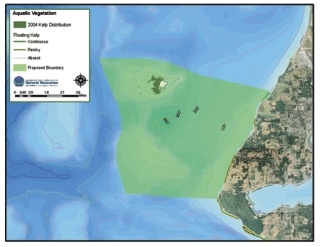One of the largest kelp beds in Washington state nearly surrounds two tiny islands off the west coast of Whidbey Island.
The underwater forest of seaweed is an ideal nursery for baby fish, according to Cyrilla Cook of People for Puget Sound. The surrounding waters support a diverse ecosystem of sea creatures, including orcas, harbor seals, salmon, halibut, lingcod, tufted puffins and black oystercatchers.
It’s such an important habitat for the species that People for Puget Sound, a nonprofit conservation group, is trying to get 30,000 acres of state-owned bedlands and tidelands turned into a state aquatic reserve.
“We looked all through Puget Sound. These areas have been identified as being the most important for bio-diversity,” Cook said, adding that various other groups have also pointed to the stretch of water as being vital habitat.
Designation as a reserve wouldn’t have an impact on fishing, crabbing or boating, Cook said, but it could mean more protection from other uses, as well as the possibility of more grant funding headed there.
People for Puget Sound actually nominated two areas as marine reserves. Off the west coast of Whidbey is the proposed, 25,000-acre Smith/Minor islands reserve. The small islands are actually joined together when the tide is right.
On Whidbey, the reserve would include the state-owned tidelands from Joseph Whidbey State Park to Fort Ebey State Park. Privately-owned property would not be affected.
The reserve would also include the waters around the two islands, which are owned and managed by the U.S. Fish and Wildlife Service as part of the San Juan Island National Wildlife Refuge.
“It’s one of the most important places for resident breeding marine birds,” Cook said.
In addition to Smith/Minor islands, the group also nominated the area around Protection Island, which is off Jefferson County, as a marine reserve.
Marine reserves, Cook explained, are managed by the state Department of Natural Resources with priority given to protecting the environment. The designation could have an impact on such uses as stormwater outfalls, net pens, tidal energy and cable crossings.
Also, the reserve would be given priority if there’s an oil spill. And the designation might mean more grant funding for restoration and other projects.
The local community plays an important role in deciding how a reserve is managed under a management plan specifically designed for the area.
The Department of Natural Resources and People for Puget Sound began the process of getting the community involved at a public hearing in Oak Harbor last month, which was attended by local officials, staff from Island County and the city of Oak Harbor, state parks officials, the Tulalip tribes representatives and citizens.
Cook said everyone seemed excited about the proposal and some even proposed expanding the boundaries.
The next step, Cook said, is for an independent team of scientists to study the area and make a recommendation about whether it should be a reserve.




